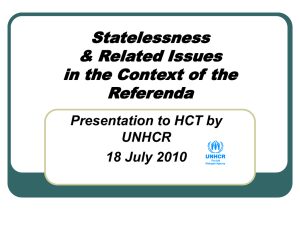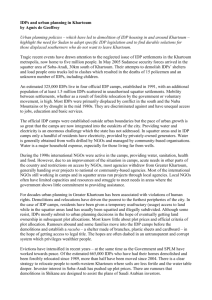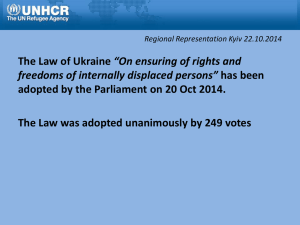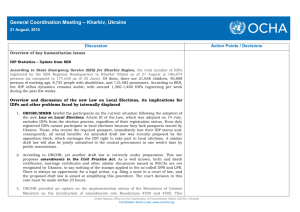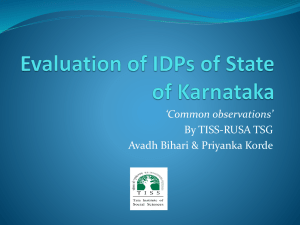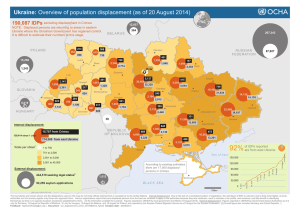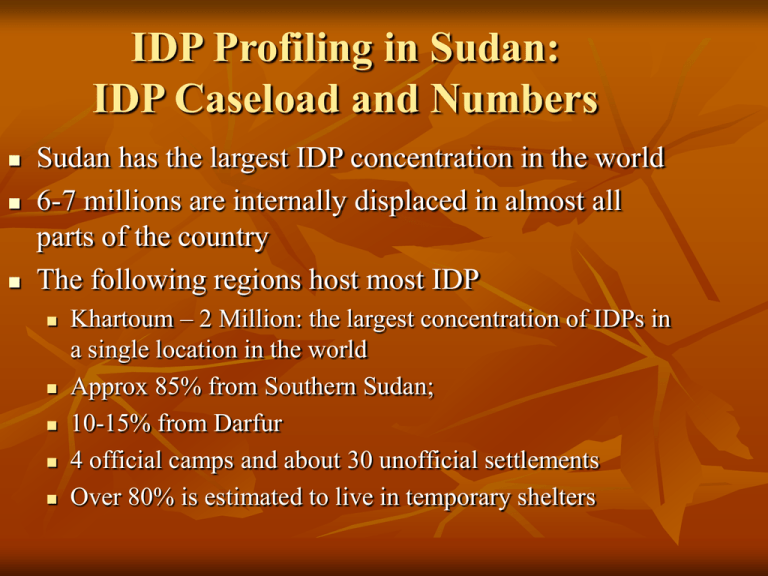
IDP Profiling in Sudan:
IDP Caseload and Numbers
Sudan has the largest IDP concentration in the world
6-7 millions are internally displaced in almost all
parts of the country
The following regions host most IDP
Khartoum – 2 Million: the largest concentration of IDPs in
a single location in the world
Approx 85% from Southern Sudan;
10-15% from Darfur
4 official camps and about 30 unofficial settlements
Over 80% is estimated to live in temporary shelters
IDP Caseload Continue…
1.8 million IDPs displaced within Darfur
Approx 1.8 million IDPs displaced in various
parts within Southern Sudan
Approx 700,000 displaced in West Darfur where
UNHCR has mandate over IDPs
Most IDPs reside in rural settlements
Remaining IDPs in elsewhere in the East and
North of Sudan
Pattern of Displacement and
Settlement
Majority of displacement owing to conflict
South Sudan conflict since mid 1980s
Darfur conflict from 2003 - present
Eastern Sudan insecurity
Drought/insecurity in central region in 1980s
Different waves/Multitude of displacement
IDP Settlement and Response
Majority of IDPs in Khartoum reside in
informal squatter settlements around city
IDPs displaced within southern Sudan, eastern
Sudan and elsewhere reside in rural
settlements/villages
Majority of Darfur IDPs reside in IDP camps
Response…Khartoum
Government relations with IDPs is characterized with
hostility and distrust – thus very limited direct
assistance and support
Access to IDP camps/settlements in Khartoum
restricted by authorities
Humanitarian assistance – primarily my INGOs reduced in recent years due to competing demands
No systematic profiling of IDPs
Until recently no protection monitoring in camps
UNHCR Involvement with IDPs in
Khartoum
UNHCR’s involvement with internally displaced
persons in Greater Khartoum area is based on a
specific request by the UN Emergency Relief
Coordinator and the Humanitarian Coordinator.
Our engagement with IDPs in Khartoum is designed
as a protection intervention, but clearly framed in the
context of the return operation to Southern Sudan.
While Sudan is not one of the pilot countries for the
IASC cluster approach for IDPs, UNHCR’s
involvement in Khartoum is still seen to derive from
this IASC policy.
UNHCR Involvement with IDPs
The outlined strategy for the project is
focusing on:
community based protection monitoring;
enhancing protection networks and coordination;
capacity-building; and
ensuring IDPs have elements for informed choice
regarding their return.
Envisioned engagement in 2007
UNHCR foresees continuing to act as advocate for IDPs in
Khartoum, in the context of the return operation, through
coordination and leadership in the PWG
The majority of the IDPs express a strong desire to return from
Khartoum. UNHCR would like to enhance the UN’s
contribution to the overall IDP return operation by jointly
(Government of Southern Sudan, Government of National
Unity/UN) organized IDP returns to selected areas.
Support would also be offered in the form of technical advice
and capacity building for the return operation, including
registration, information dissemination, etc
IDP Profiling in Khartoum
Two types of profiling in different times through
inter-agency efforts:
Assessment of socio-economic condition of IDPs with the
objective:
To identify the reasons for the IDP displacement and their principal
demographic breakdown;
To determine socio-economic needs;
To serve as reference tool to support policy design and programme
development that will ensure assistance
To Identify skill levels and IDPs’ needs for further training;
Verify anecdotal evidence concerning re-planning process and plot
allocation
Profiling Conti…
Methodology: Random sample selection of IDP households from major
IDP camps/settlements
The 4 most populous IDP camps selected with a total 400,000 IDPs
Sample size of approx. 1,500 households
The sample survey covered the following areas
Socio-economic status
Water, sanitation and health
IDP/ returnee status
Plot procurement and relocation impact
Protection issues
Focus Group Discussions qualitative methodology was also used
The survey report and analyses were widely shared through interagency forums and were used to inform humanitarian programming.
Other issue-specific profiling were also done in IDP camps
Return Intention Profiling
In Mid 2005 UNHCR co-sponsored IDP survey intention in Northern
Sudan. The Gov. requested such survey and was an integral part of te
process, providing IDP statistics and locations.
The main objective of the survey included:
Carry out a survey to collect data on the intentions, motivations, and
concerns of IDPs regarding voluntary return to South Sudan.
Identify IDPs’ desire to settle elsewhere or their decision to remain
in current places of displacement.
Obtain numerical estimates of persons who may be returning to their
places of origin in the next three to twelve months.
Indicate geographic locations of potential final destinations as well
as planned return routes
Collect basic demographic data (disaggregated by age, sex, and
family composition) and socio-economic information on IDP
populations.
Intention Profiling Cont…
Determine as to what information IDPs need to make an
informed choice about return
Seek information about land and property in order to gather
information about potential problems or concerns of IDPs
about their possible return
Include sections on advocacy and health relevant for
partner agencies.
Highlights the priorities to be taken into account when
planning return and reintegration of the IDPs.
Intention Profiling Cont…
Methodology: The sample survey.
The estimated number of the IDPs considered for the
population frame was approx. 2.9 million IDPs, living in 11
states (54 survey locations) and corresponding to 482,630
households. For the survey interviews, 7,020 households were
selected and interviewed, corresponding to 44,238 persons.
The process also served a capacity building purpose for gov.
counterpart
Intention Profiling Cont…
Key findings include:
The majority of IDPs, 68% of the total, said that they
would return, 11% said that they have not decided yet and
22% said that they will remain in where they are.
The decision to return varied by areas of origin. For the
IDPs who originate from South Sudan, 80% said that they
would return (78% to their place of origin and 2% to other
village/town).
Other 10% of the southerners stated that they have not
decided yet and the remainder 10% said that they will not
return.
Intention Profiling Cont…
All respondents who declared they would return were
asked what additional information they would like to have
for helping their returning decisions. The most frequently
mentioned need was information on safe routes (43%).
The cost of travel and information on conditions at the
place of origin were also mentioned by large groups
(respectively 39% and 35%).
Information collected by the sample was used to develop
registration and profiling systems; informed options for and
facilitate such durable solutions as voluntary return, local
integration or settlement in areas other that the places of origin
or displacement.

